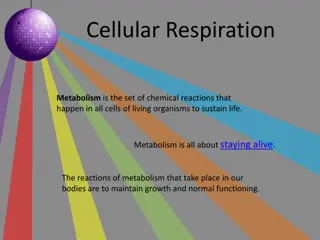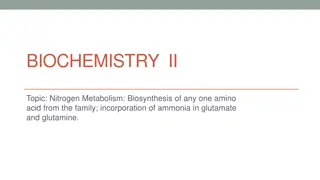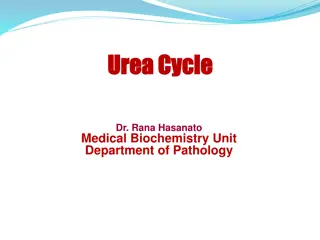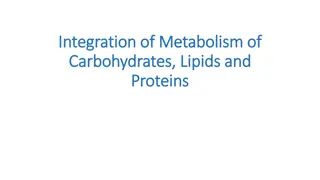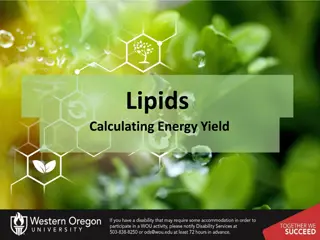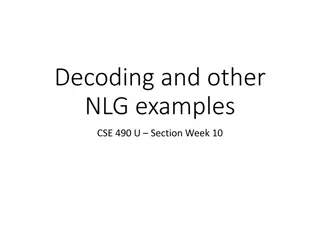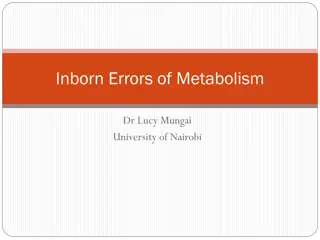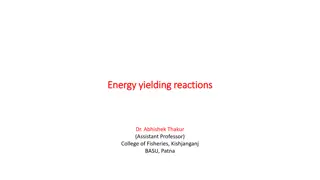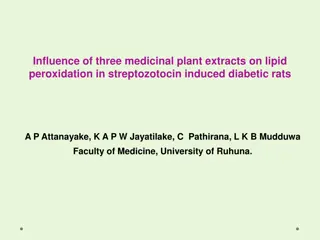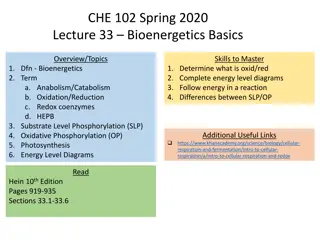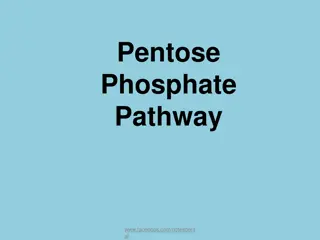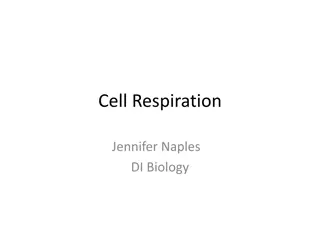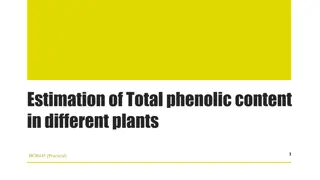Decoding Oxidative Decarboxylation and Krebs Cycle in Energy Metabolism
Explore the intricate processes of oxidative decarboxylation and the Krebs Cycle, essential pathways in cellular energy metabolism. Learn about the conversion of pyruvate to acetyl-CoA, regulatory mechanisms, clinical implications, and more. Discover the fates of pyruvate, allosteric regulation, and the significance of PDH complex. Uncover how deficiencies in thiamine or niacin can lead to serious CNS issues and the impact of PDH complex deficiency on lactic acidosis. Dive into the tricarboxylic acid cycle (Krebs) and its role in energy metabolism.
Download Presentation

Please find below an Image/Link to download the presentation.
The content on the website is provided AS IS for your information and personal use only. It may not be sold, licensed, or shared on other websites without obtaining consent from the author.If you encounter any issues during the download, it is possible that the publisher has removed the file from their server.
You are allowed to download the files provided on this website for personal or commercial use, subject to the condition that they are used lawfully. All files are the property of their respective owners.
The content on the website is provided AS IS for your information and personal use only. It may not be sold, licensed, or shared on other websites without obtaining consent from the author.
E N D
Presentation Transcript
Oxidative Decarboxylation Oxidative Decarboxylationand Krebs KrebsCycle Cycle and By Reem M. Sallam, M.D.;Ph.D. Clinical Chemistry Unit, Pathology Dept. College of Medicine, King Saud University
Objectives: OxidativeDecarboxylation By the end of this lecture, students are expected to: Recognize the various fates of pyruvate Define the conversion ofpyruvate to acetyl CoA Discuss the major regulatory mechanisms for PDH complex Recognize the clinical consequence of abnormal oxidative decarboxylation reactions
Objectives: KrebsCycle By the end of this lecture, students are expected to: Recognize the importance of Krebs cycle Identify various reactions of Krebs cycle Define the regulatory mechanisms of Krebs cycle Assess the energy yield of PDH reaction and Krebs cycle s reactions
Fates Fates of ofPyruvate Pyruvate ALT Alanine PLP KG Glutamate PLP = PyridoxalPhosphate
Oxidative Decarboxylation Oxidative Decarboxylation of ofPyruvate Pyruvate Allosteric Regulation
PDH Complex: Covalent PDH Complex: CovalentRegulation Regulation + - Insulin PDH Ca2+ Insulin Glucago n PDH + P Pi H2O Protein Phosphatase Pyruvate dehydrogenase complex(inactive) Pyruvate dehydrogenase complex(active) Protein Kinase + ATP ADP Glucagon
PDH Reaction: Clinicalapplication 1. Deficiencies of thiamine or niacin can cause seriousCNS problems.WHY? Brain cells are unable to produce sufficientATP if the PDH complex isinactive. 2. Wernicke-Korsakoff (encephalopathy-psychosis syndrome) due to thiamine deficiency,maybe seen especially with alcoholabuse. 3. PDH complex deficiency is the mostcommon biochemical cause of congenital lactic acidosis.
Krebs KrebsCycle Cycle The tricarboxylic acid cycle (Krebs) shown as a part of the essential pathways of energy metabolism. CoA= coenzymeA.
Tricarboxylic Tricarboxylic Acid Cycle: Krebs Acid Cycle: KrebsCycle Final common pathway for oxidation Exclusively in mitochondria Major source forATP Mainly catabolic with some anabolic features Synthetic reactions (anabolic features): Glucose from amino acids Nonessential amino acids Fatty acids Heme Cycle
Krebs Krebs Cycle Cycle Reactions Reactions(1) (1) Formation of -ketoglutarate from acetyl coenzyme A (CoA) andoxaloacetate. NAD(H) = Nicotinamide adeninedinucleotide.
Krebs Krebs Cycle Cycle Reactions Reactions(2) (2) Succinate Thiokinase Substrate-Level Phosphorylation Formation of malate from -ketoglutarate. NAD(H) = nicotinamide adenine dinucleotide; GDP = guanosinediphosphate; P = phosphate; CoA = coenzyme A; FAD(H2) = flavin adeninedinucleotide.
Krebs Krebs Cycle Cycle Reactions Reactions(3) (3) Formation (regeneration) of oxaloacetate frommalate. NAD(H) = nicotinamide adeninedinucleotide
Krebs Cycle: Krebs Cycle: Energy EnergyYield Yield Number of ATP molecules produced from the oxidation of one molecule ofacetyl coenzyme A (CoA) using both substrate-level and oxidativephosphorylation.
Krebs Cycle: Krebs Cycle: Energy EnergyYield Yield Number of ATP molecules produced from the oxidation of one molecule ofacetyl coenzyme A (CoA) using both substrate-level and oxidativephosphorylation.
Net Net ATP ATP Production Productionby Complete Complete Glucose GlucoseOxidation by Oxidation Aerobic glycolysis: 8ATP Oxidative decarboxylation: 6ATP 2 X 3 = Krebs cycle: 2 X 12 = 24ATP Net: 38ATP
Regulation of OxidativeDecarboxylation and KrebsCycle PDH complex and the TCA cycle are bothup- regulated in response to a decrease in the ratio of ATP:ADP NADH:NAD+ TCA cycle activatorsare: ADP Ca2+ TCA cycle inhibitorsare: ATP NADH
Take Take Home HomeMessage Message Pyruvate is oxidatively decarboxylated by PDH to acetyl CoA inside the mitochondria Krebs cycle: Final common pathway for the oxidation of carbohydrates, fatty acids and amino acids occurs in the mitochondria Aerobic Mainly catabolic, with some anabolic reactions The complete oxidation of one glucose molecule results in a net production of 38 ATPmolecules




